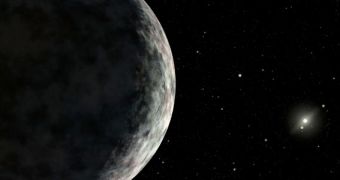The team of astronomers that identified a new dwarf planet in our solar system at the end of last month now argues that the discovery may hold clues about how life originated here on Earth. The object they found is designated 2012 VP133, but it is informally known as Biden, after US Vice-President Joe Biden.
The object lies beyond the Kuiper Belt, a dense group of asteroids orbiting the Sun well beyond the orbit of Neptune. Thus far, only two dwarf planets have been discovered beyond this asteroid belt, namely Biden and Sedna. The latter was found 10 years ago and lies about three times farther away from the Sun than Neptune.
Sedna's farthest point from the Sun, or aphelion, is around 937 astronomical units (AU), while its perihelion is at 76 AU. By comparison, Earth lies just 1 AU away from the Sun, a distance equal to the mean distance between the two objects – 157 million kilometers, or 93 million miles. According to researchers, Biden shares some of its orbital characteristics with Sedna, Space reports.
The celestial body was announced in a paper entitled “A Sedna-like body with a perihelion of 80 astronomical units,” in the March 26 issue of the top journal Nature. The object was identified by Scott Sheppard, a faculty member with the Department of Terrestrial Magnetism (DTM) at the Carnegie Institution for Science, and Chadwick Trujillo, an astronomer with the Gemini Observatory.
The team says that many more objects such as Biden and Sedna may exist beyond the Kuiper Belt and argues that most of them may contain carbon-based materials called organics, which represent the main chemical ingredients needed for the development of life. As such, finding and mapping these dwarf planets may one day explain how life arose here on Earth, the two say.
More far-reaching questions could also be addressed through this type of studies. For instance, one of the most important questions astronomers are interested in answering is whether or not these organic molecules could constitute a potential source for life on Earth, having arrived here early on in the history of the solar system. Stemming from this, could a similar scenario apply to other star systems, too?
Next year, experts could gain a deeper insight into these issues, as the NASA New Horizons probe is scheduled to finally fly by Pluto. The spacecraft – the fastest ever built by humans – was launched in 2006 and has been flying at great speed towards the dwarf planet ever since. Due to its high speed, it will not be able to enter orbit around this celestial body, but it will rather image it as it flies past.
After its encounter with Pluto, New Horizons will continue zooming toward the Kuiper Belt, analyzing multiple objects as it flies through the asteroid belt. It is entirely possible that the probe will be able to identify new worlds as it does so or that its sensitive detectors will confirm or infirm the existence of organic molecules on already-known objects.

 14 DAY TRIAL //
14 DAY TRIAL //